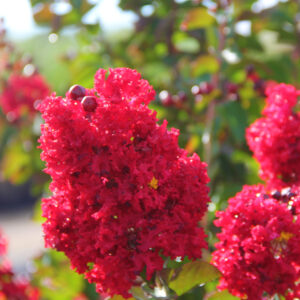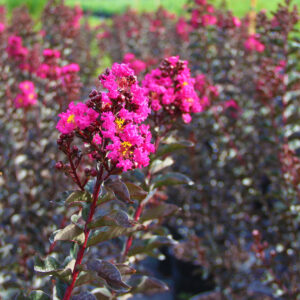By: Anna Stubbendick, FCHP
Summer is just around the corner, and what better way to spruce up your garden than with beautiful Crape Myrtles? These vibrant flowering trees are always a popular choice, and we’re excited to offer our annual 15% off sale on all Crape Myrtles starting May 1st!
Check out the chart below for some of the different varieties we offer:
| Variety | Bloom Color | Growth Habit | Mature Size | Growth Rate |
|---|---|---|---|---|
| Catawba | Purple | Upright | 15-25 ft. tall, 10-20 ft. wide | Fast |
| Dynamite | Red | Rounded | 20-30 ft. tall, 15-25 ft. wide | Medium |
| Ebony (Purple) | Purple | Upright | 10-15 ft. tall, 8-10 ft. wide | Medium |
| Ebony (White) | White | Upright | 10-15 ft. tall, 8-10 ft. wide | Medium |
| Ebony (Red) | Red | Upright | 10-15 ft. tall, 8-10 ft. wide | Medium |
| Ebony (Pink) | Pink | Upright | 10-15 ft. tall, 8-10 ft. wide | Medium |
| Enduring Summer | Red | Rounded | 6-12 ft. tall, 6-8 ft. wide | Medium |
| Muskogee | Lavender | Upright | 20-30 ft. tall, 15-25 ft. wide | Fast |
| Natchez | White | Upright | 20-30 ft. tall, 15-25 ft. wide | Fast |
| Sioux | Pink | Upright | 20-30 ft. tall, 15-25 ft. wide | Fast |
| Tuskegee | Dark Pink | Upright | 15-25 ft. tall, 10-20 ft. wide | Medium |
| Tuscarora | Coral | Upright | 20-30 ft. tall, 15-25 ft. wide | Fast |

The ‘Tuskegee’ Crape myrtle is a stunning choice with its deep pink, almost red blooms. Photo by Anna Stubbendick, Canterbury Farms
Planting and Caring for Crape Myrtles
Crape Myrtles are easy to care for and thrive in full sun and well-draining soil. Make sure to plant them in a hole that is twice as wide as the root ball and just as deep. Water regularly during the first year of growth to establish a strong root system. Apply a layer of mulch around the base of the tree to help retain moisture and prevent weeds.
Pruning Crape Myrtles
Pruning Crape Myrtles is easy and can be done in late winter or early spring. Simply prune any dead or diseased wood and remove any suckers that grow from the base of the tree. Avoid “topping” the tree, as this can cause weak growth and unsightly branching.
What About “Crape Murder?”

The white ‘Natchez’ and lavender ‘Muskogee’ Crape Myrtles are the largest of the varieties grown at Canterbury Farms. When allowed to grow in their natural form, they can make stately specimen trees in any yard. Photo by Anna Stubbendick, Canterbury Farms
Ah yes, “Crape Murder” is a common term used to describe the harmful and unsightly practice of severely pruning back Crape Myrtles. This is often done by cutting the branches back to stubs or “knuckles” in an effort to promote larger blooms or a specific shape.
Unfortunately, this practice can cause more harm than good. It not only ruins the natural shape of the tree, but it also weakens the branches and leaves them susceptible to disease and pests. Plus, it can actually reduce the number of blooms that the tree produces.
So, we strongly advise against “Crape Murder” and instead recommend proper pruning techniques, such as removing dead or diseased wood and shaping the tree gradually over time. This will not only keep your Crape Myrtles healthy and beautiful, but it will also save you from having to deal with the aftermath of “Crape Murder”.

Elegant ‘Ebony’ Crape Myrtles are striking with their deep red, almost black leaves. They are available in several different bloom colors including white, red, purple, and pink. Photo by Anna Stubbendick, Canterbury Farms
Get Ready for Summer with Crape Myrtles
With our annual 15% off sale on all Crape Myrtles, starting May 1st, there’s no better time to add these beautiful plants to your yard. Whether you’re looking for a pop of color or a statement piece, we’ve got you covered. Stop by our nursery to check out our selection and get advice on the best variety for your needs. Happy gardening!
